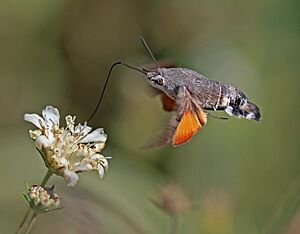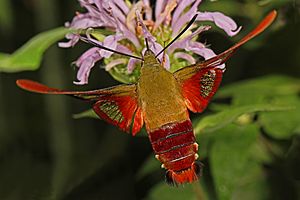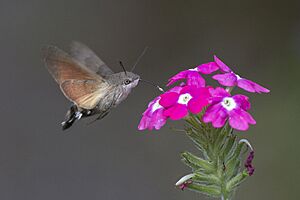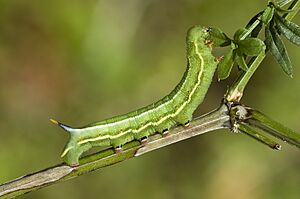Hummingbird moth facts for kids

Hummingbird moths are amazing insects that often get mistaken for tiny hummingbirds! These fascinating creatures are actually a type of sphinx moth and are known for their speedy flight and ability to hover while feeding on flower nectar. They are found in many parts of the world, bringing a touch of magic to gardens and meadows.
Contents
What is a Hummingbird Moth?
Hummingbird moths belong to a large family of moths called Sphingidae, also known as sphinx moths or hawk-moths. They earned their common name because of their unique behavior: they fly during the day, make a buzzing sound, and hover in front of flowers, just like hummingbirds do! This makes them quite special, as most moths are active at night.
These moths have strong bodies and narrow wings, which help them fly very fast. They also have a long, straw-like mouthpart called a proboscis, which they unroll to sip nectar from deep inside flowers.
Types of Hummingbird Moths
While many moths in the sphinx family might look a bit like hummingbirds, two species are most commonly known as "hummingbird moths."
The Hummingbird Hawk-Moth (Macroglossum stellatarum)
This species is found across Europe, Asia, and North Africa. It has a wingspan of about 4 to 5 centimeters (1.6 to 2 inches). Its front wings are brownish-orange, and its hind wings are a brighter orange. The body is thick and furry, with black and white markings on its tail, making it look even more like a bird.
Hummingbird hawk-moths are very active during sunny days, especially in gardens, parks, and open woodlands. They are strong flyers and can even migrate long distances to warmer places for winter.
The Hummingbird Clearwing (Hemaris thysbe)

Native to North America, the hummingbird clearwing is another popular "hummingbird moth." It gets its name from its clear, scale-free wings, which look like tiny windows! When they first emerge from their cocoons, their wings are covered in scales, but these fall off after their first flight.
These moths have a fuzzy, greenish-yellow body with a reddish-brown band across their back. They are a bit smaller than the hawk-moth, with a wingspan of about 3 to 5 centimeters (1.2 to 2 inches). You can often spot them in gardens, fields, and forest edges, especially during the warmer months.
Where Do They Live? (Habitat)
Hummingbird moths are quite adaptable and can be found in various habitats. The hummingbird hawk-moth prefers temperate regions and is common in gardens, parks, and open woodlands across Eurasia. They enjoy areas with plenty of flowering plants.
The hummingbird clearwing lives throughout North America, from Canada down to Florida and Texas. They thrive in sunny areas like meadows, open fields, and suburban gardens where nectar-rich flowers are abundant.
What Do They Eat? (Diet)
Both the adult hummingbird hawk-moth and the hummingbird clearwing feed exclusively on nectar from flowers. They use their long proboscis to reach deep into tubular flowers. They are important pollinators, helping plants reproduce as they move from flower to flower.
Some of their favorite flowers include honeysuckle, lavender, phlox, bee balm, and zinnia. Their caterpillars, however, have a different diet. For example, hummingbird hawk-moth caterpillars feed on plants like bedstraw and madder, while hummingbird clearwing caterpillars prefer honeysuckle, hawthorn, and viburnum.
Life Cycle of a Hummingbird Moth
Like all moths, hummingbird moths go through a complete metamorphosis, which means they change dramatically during their life.
- Egg: The life cycle begins when the female moth lays tiny, spherical eggs, usually on the leaves of specific host plants.
- Larva (Caterpillar): After a few days, the eggs hatch into caterpillars. These caterpillars are often green or yellowish with a horn-like tail at the end of their body. They spend their time eating leaves and growing quickly, shedding their skin several times as they get bigger.
- Pupa: Once the caterpillar is fully grown, it forms a pupa. For the hummingbird hawk-moth, this usually happens in a loose cocoon on the ground or among leaf litter. The hummingbird clearwing caterpillar often burrows into the soil to pupate. Inside the pupa, the caterpillar transforms into an adult moth.
- Adult: After a period, which can be weeks or months depending on the species and climate, the adult moth emerges from the pupa. It then flies off to find a mate and start the cycle all over again.
Amazing Adaptations
Hummingbird moths have several incredible adaptations that help them survive and thrive:
- Hovering Flight: Their powerful wing muscles allow them to hover perfectly still in the air, just like hummingbirds. This lets them feed on nectar without landing on the flower.
- Long Proboscis: Their extra-long proboscis is perfectly designed to reach nectar in deep flowers, giving them access to food that other insects might miss.
- Mimicry: By looking and acting like hummingbirds, they might trick predators into thinking they are birds, which are often less appealing prey than moths.
- Diurnal Activity: Unlike most moths, they are active during the day. This allows them to feed on flowers that are open in daylight and avoid many nocturnal predators.
Protecting Hummingbird Moths
Hummingbird moths are important parts of our ecosystem, especially as pollinators. You can help protect them by planting native flowers in your garden that provide nectar for adults and host plants for their caterpillars. Reducing the use of pesticides also helps keep these amazing insects safe.
Images for kids





